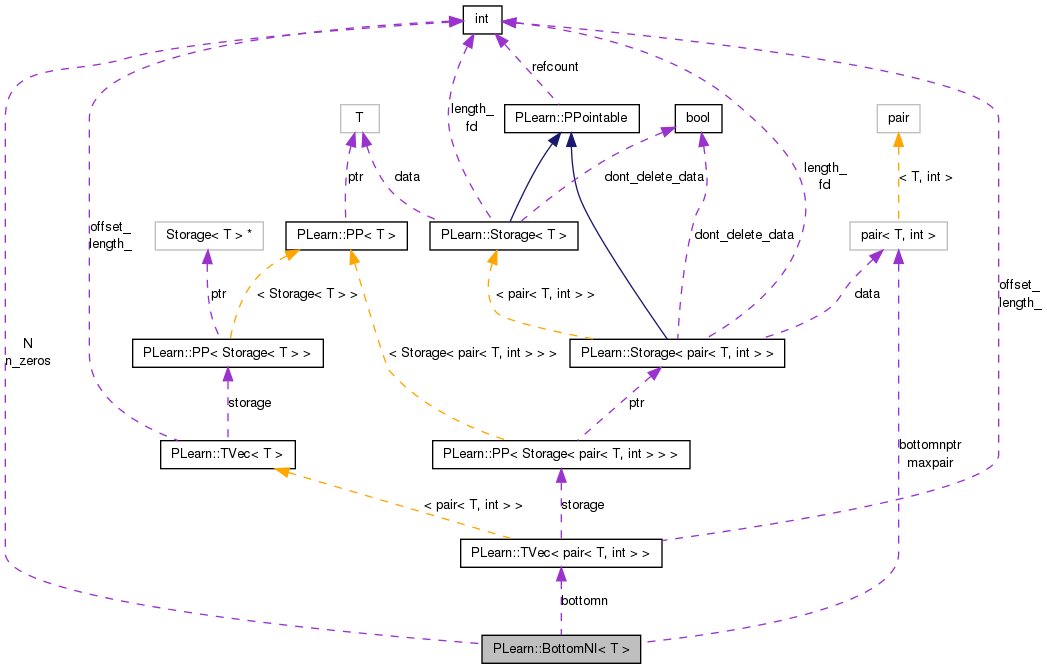|
PLearn 0.1
|
|
PLearn 0.1
|
#include <BottomNI.h>

Public Member Functions | |
| BottomNI () | |
| Default constructor, you must then call init. | |
| BottomNI (int the_N) | |
| N is the number of (value,index) pairs to remember. | |
| void | init (int the_N) |
| N is the number of (value,point) pairs to remember. | |
| void | reset () |
| void | update (T value, int index) |
| call this for each new value seen | |
| int | nZeros () const |
| void | sort () |
| const TVec< pair< T, int > > & | getBottomN () |
| call this at the end to get the the smallest N values with associated integer index | |
Protected Attributes | |
| int | n_zeros |
| number of zeros | |
| int | N |
| TVec< pair< T, int > > | bottomn |
| pair< T, int > * | bottomnptr |
| bottomn.data() | |
| pair< T, int > * | maxpair |
This is a very simple class, that allows you to keep track of the bottom N values encountered among many and their associated integer index (or corresponding position). For keeping track of the TOP N values, see the companion class TopNI.
Definition at line 62 of file BottomNI.h.
| PLearn::BottomNI< T >::BottomNI | ( | ) | [inline] |
Default constructor, you must then call init.
Definition at line 74 of file BottomNI.h.
: n_zeros(0), N(0), bottomnptr(0), maxpair(0) { }
| PLearn::BottomNI< T >::BottomNI | ( | int | the_N | ) | [inline] |
N is the number of (value,index) pairs to remember.
Definition at line 79 of file BottomNI.h.
: n_zeros(0), N(0), bottomnptr(0), maxpair(0) { init(the_N); }
| const TVec< pair<T,int> >& PLearn::BottomNI< T >::getBottomN | ( | ) | [inline] |
call this at the end to get the the smallest N values with associated integer index
Definition at line 130 of file BottomNI.h.
Referenced by PLearn::computeNearestNeighbors(), PLearn::LocalizedFeaturesLayerVariable::computeSubsets(), PLearn::evaluateKernelBottomN(), and PLearn::BaseRegressorConfidence::train().
{ return bottomn; }

| void PLearn::BottomNI< T >::init | ( | int | the_N | ) | [inline] |
N is the number of (value,point) pairs to remember.
< reserve space for N elements
< set length back to 0
< ptr for faster access
Definition at line 84 of file BottomNI.h.
References N.
Referenced by PLearn::LocalizedFeaturesLayerVariable::computeSubsets().

| int PLearn::BottomNI< T >::nZeros | ( | ) | const [inline] |
Definition at line 124 of file BottomNI.h.
Referenced by PLearn::computeNearestNeighbors().
{return n_zeros;}

| void PLearn::BottomNI< T >::reset | ( | ) | [inline] |
| void PLearn::BottomNI< T >::sort | ( | ) | [inline] |
Definition at line 126 of file BottomNI.h.
Referenced by PLearn::computeNearestNeighbors(), PLearn::evaluateKernelBottomN(), and PLearn::BaseRegressorConfidence::train().
{ std::sort(bottomnptr, bottomnptr+bottomn.length()); }

| void PLearn::BottomNI< T >::update | ( | T | value, |
| int | index | ||
| ) | [inline] |
call this for each new value seen
find the new maximum:
Definition at line 96 of file BottomNI.h.
Referenced by PLearn::computeNearestNeighbors(), PLearn::LocalizedFeaturesLayerVariable::computeSubsets(), PLearn::evaluateKernelBottomN(), and PLearn::BaseRegressorConfidence::train().
{
int l=bottomn.length();
if(value==0)
n_zeros++;
if(l<N)
{
bottomn.append( pair<T,int>(value,index) );
if (l==0 || value>maxpair->first)
maxpair = &bottomnptr[l];
}
else if(value<maxpair->first)
{
maxpair->first = value;
maxpair->second = index;
pair<T,int>* it = bottomnptr;
int n = N;
while(n--)
{
if(it->first>maxpair->first)
maxpair = it;
++it;
}
}
}

TVec< pair<T,int> > PLearn::BottomNI< T >::bottomn [protected] |
Definition at line 67 of file BottomNI.h.
pair<T,int>* PLearn::BottomNI< T >::bottomnptr [protected] |
bottomn.data()
Definition at line 68 of file BottomNI.h.
pair<T,int>* PLearn::BottomNI< T >::maxpair [protected] |
Definition at line 69 of file BottomNI.h.
int PLearn::BottomNI< T >::N [protected] |
Definition at line 66 of file BottomNI.h.
int PLearn::BottomNI< T >::n_zeros [protected] |
number of zeros
Definition at line 65 of file BottomNI.h.
 1.7.4
1.7.4